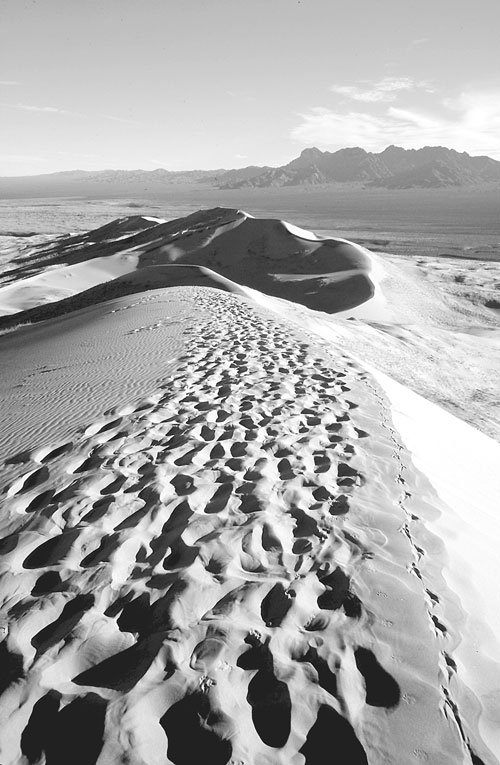 Facebook
Facebook
 X
X
 Instagram
Instagram
 TikTok
TikTok
 Youtube
Youtube

Booming, roaring, barking, squeaking, and whistling sands have figured in folklore and travelers' tales for 1500 years, with the earliest references found in Chinese and Mideastern chronicles. Marco Polo describes encountering the phenomenon on a journey through the Gobi desert; Charles Darwin mentions it while traveling through Chile; and it crops up in the writings of Henry David Thoreau.
Imaginative legends speak of the groaning of subterranean deities, of the incantations of ghosts, and of the chiming of bells in a sand-drowned monastery. In reality the sound emanates from a peculiar vibration associated with sand flowing down the slip face (steepest face) of certain rare dunes and sand drifts known as "booming dunes." The nearest such dunes to San Diego are the increasingly popular Kelso Dunes in the heart of the Mojave National Preserve, east of Barstow.
Booming dunes are visually indistinguishable from normal sand dunes -- but not so on a microscopic scale. Booming-dune sand grains are round and polished, the result of being pushed and tumbled by prevailing winds over distances of dozens of miles or more. When such sand begins to flow downward, the grains vibrate in unison in some as yet not fully explained way. The surface of the dune around the sliding sand resonates with a sound reminiscent of old-fashioned propeller aircraft flying overhead.
Strong winds can trigger spontaneous cascades of sand, along with the attendant sounds. But even during quiet conditions, you can produce sounds to your liking by trying the following method, described by researcher A.D. Lewis while on an expedition to the Kalahari dunes of South Africa in 1935:
"By sliding down the slope in slow jerks on one's 'sit-upon'...a very loud roar is produced. In the still of the evening and early morning, natives were kept sliding down the slope in this way, and the noise was easily heard at a distance of 600 yards, like the rumbling of distant thunder."
This and other even more imaginative techniques can be used while atop the highest crest of the Kelso Dunes, rising nearly 700 feet above the desert floor. Like all booming dunes, these will boom best in the warmest, driest weather -- so June is the perfect month. Plan to arrive late in the day, when the temperature sinks below 100 degrees. The hike to the top involves more than a mile of tedious slogging in soft sand, so don't forget to take plenty of water!
To reach the Kelso Dunes, drive 78 miles east of Barstow on Interstate 40, go north on Kelbaker Road for 13 miles, then turn west on a marked, graded road leading 3 miles to the trailhead. For more information about the dunes and about the Mojave National Preserve, call 760-733-4040 or 760-255-8801.


Booming, roaring, barking, squeaking, and whistling sands have figured in folklore and travelers' tales for 1500 years, with the earliest references found in Chinese and Mideastern chronicles. Marco Polo describes encountering the phenomenon on a journey through the Gobi desert; Charles Darwin mentions it while traveling through Chile; and it crops up in the writings of Henry David Thoreau.
Imaginative legends speak of the groaning of subterranean deities, of the incantations of ghosts, and of the chiming of bells in a sand-drowned monastery. In reality the sound emanates from a peculiar vibration associated with sand flowing down the slip face (steepest face) of certain rare dunes and sand drifts known as "booming dunes." The nearest such dunes to San Diego are the increasingly popular Kelso Dunes in the heart of the Mojave National Preserve, east of Barstow.
Booming dunes are visually indistinguishable from normal sand dunes -- but not so on a microscopic scale. Booming-dune sand grains are round and polished, the result of being pushed and tumbled by prevailing winds over distances of dozens of miles or more. When such sand begins to flow downward, the grains vibrate in unison in some as yet not fully explained way. The surface of the dune around the sliding sand resonates with a sound reminiscent of old-fashioned propeller aircraft flying overhead.
Strong winds can trigger spontaneous cascades of sand, along with the attendant sounds. But even during quiet conditions, you can produce sounds to your liking by trying the following method, described by researcher A.D. Lewis while on an expedition to the Kalahari dunes of South Africa in 1935:
"By sliding down the slope in slow jerks on one's 'sit-upon'...a very loud roar is produced. In the still of the evening and early morning, natives were kept sliding down the slope in this way, and the noise was easily heard at a distance of 600 yards, like the rumbling of distant thunder."
This and other even more imaginative techniques can be used while atop the highest crest of the Kelso Dunes, rising nearly 700 feet above the desert floor. Like all booming dunes, these will boom best in the warmest, driest weather -- so June is the perfect month. Plan to arrive late in the day, when the temperature sinks below 100 degrees. The hike to the top involves more than a mile of tedious slogging in soft sand, so don't forget to take plenty of water!
To reach the Kelso Dunes, drive 78 miles east of Barstow on Interstate 40, go north on Kelbaker Road for 13 miles, then turn west on a marked, graded road leading 3 miles to the trailhead. For more information about the dunes and about the Mojave National Preserve, call 760-733-4040 or 760-255-8801.
Comments